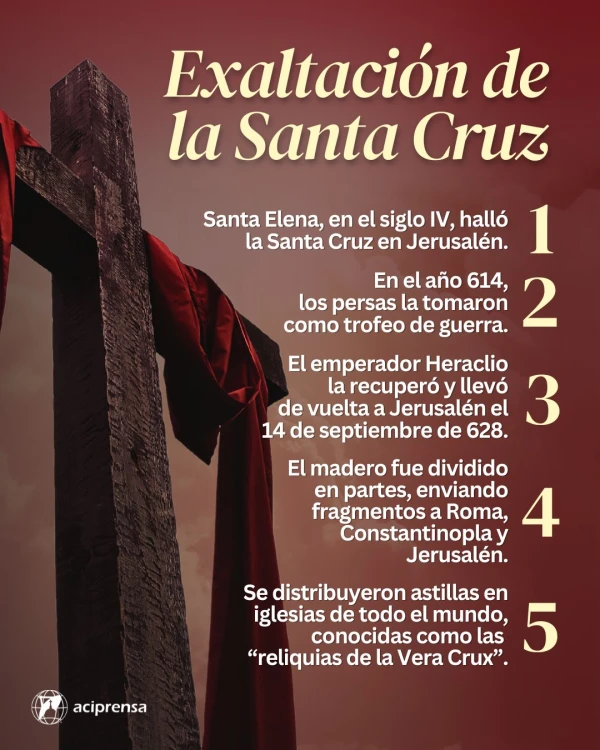Every September 14, the Feast of the Exaltation of the Holy Cross is celebrated, a day when we remember and honor the cross on which our Lord Jesus Christ died. The contemplation of that tree, on which our Savior poured his most precious blood, is an open door to the mystery of divine love, poured out without measure on the human race.
The cross of Christ, Pope Saint John Paul II taught, is the cross “on which one dies in order to live; to live in God and with God, to live in truth, in freedom and in love, to live eternally.”
Receive the main news from ACI Prensa by WhatsApp and Telegram
It is increasingly difficult to see Catholic news on social media. Subscribe to our free channels today:
September 14
According to tradition, in the 4th century, the empress Saint Helena – mother of Emperor Constantine – after an intense search, found in Jerusalem the stake on which Jesus Christ, the Son of God, died.
The relic would remain in the city until, around the year 614, it would be stolen by the Persians as a ‘war trophy’. Years later, the Eastern Roman emperor, Heraclius (emperor between 610 and 641), rescued the holy wood so that it could be sent back to the Holy City, Jerusalem, on September 14, 628.
Since then, every September 14, this event is remembered and celebrated, later instituted as a liturgical festival.

Before the cross, strip yourself of everything!
To celebrate the return of the Holy Cross to Jerusalem, Heraclius ordered that it be carried in a solemn procession. He would personally accompany the procession, dressed in all his imperial ornaments. Curiously, these became so many and so heavy that it became impossible for him to advance on the road. Then, the Archbishop of Jerusalem, Zechariah, told him: “All that luxury of clothing that he wears is at odds with the humble and painful appearance of Christ, when he was carrying the cross through these streets.”
Tradition says that the emperor immediately took off his luxurious cloak and his gold crown and, barefoot, began to walk, more quickly, through the streets, accompanying the holy procession.
Later, the holy wood was divided into parts. One fragment was sent to Rome, another to Constantinople, while a third remained in Jerusalem. The remaining piece was reduced to chips, which would be distributed by different churches around the world. These splinters were called the “relics of the Vera Crux” (the true cross).
Protected by a signal
In the narratives of the lives of the saints it is said that Saint Anthony Abbot (251-356) made the sign of the cross every time he was attacked by the devil with horrible visions and temptations.
The signal was enough for the enemy to flee. Thus, Christians adopted the custom of crossing themselves to ask for God’s protection in the presence of evil and the dangers that lurk.
In Spain and America
Today, in a special way, the Cross is present in our minds and hearts, as present as it is in the life of Latin America: rooted in the depths of our history and traditions.
To do this, it is enough to remember how many mountains, next to our cities, valleys and roads, are crowned with a cross; Our churches, chapels and bell towers are also crowned. It is enough to look at the top of buildings, schools or hospitals, as well as direct your gaze with devotion towards the walls or corners of our homes. The cross, a sign of death and ignominy, was transformed into the sign of love, hope and salvation par excellence.
Let us carry the cross, a redeeming sign, always close to our hearts.
Through the wood, joy has come to the entire world!
